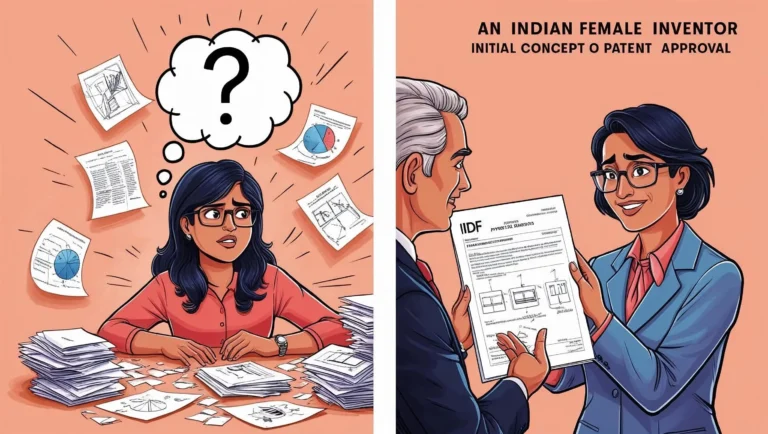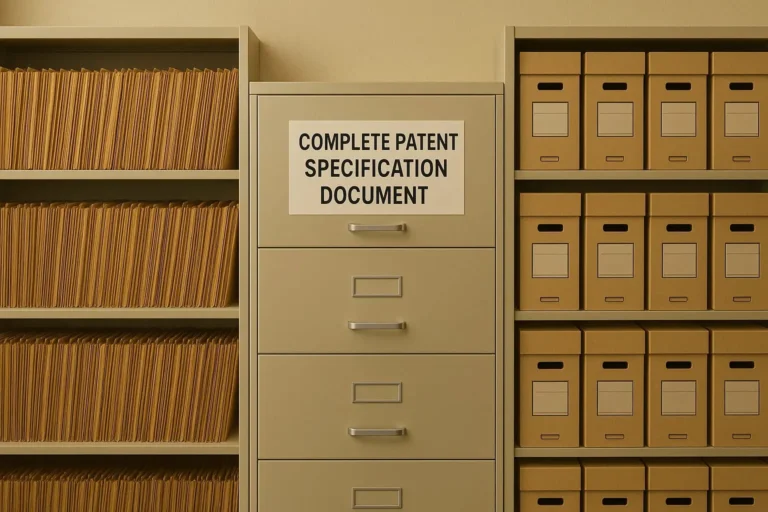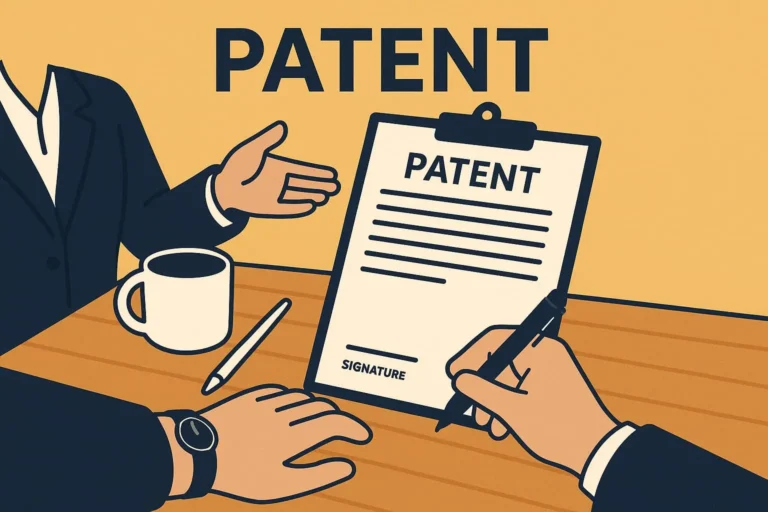The Ultimate Guide to Drafting a Provisional Patent Specification: Secure Your Invention Rights
Table of Contents
- Introduction to Provisional Patent Applications
- Key Benefits of Filing a Provisional Patent Application
- Essential Elements Your Provisional Patent Specification Must Include
- Step-by-Step Process for Drafting an Effective Provisional Specification
- Common Mistakes Inventors Make When Filing Provisional Patents
- Provisional Patent Application Template for Successful Filing
- Real-World Example: Drafting a Provisional Patent for a Gas Stove Knob
- What to Do After Filing Your Provisional Patent Application
- Conclusion: Maximizing Protection Through Quality Provisional Patent Drafting
Introduction to Provisional Patent Applications
After spending over fifteen years helping inventors navigate the patent filing process in India, USA, EP and other jurisdictions, I have witnessed the struggles many face when attempting to draft their first provisional patent specification. This comprehensive guide aims to demystify the provisional patent filing process based on my personal experience and provide practical guidance on how to effectively draft a provisional patent specification that establishes a strong foundation for your invention’s protection.
The provisional patent application serves as your first step in the patent journey, providing a placeholder that secures your filing date for up to one year before you need to file a complete specification. Though many inventors perceive provisional applications as simple formalities, my experience has shown that a carefully drafted provisional specification can make a significant difference in the ultimate success of your patent application. Let me guide you through the process I have refined over years of practice to help countless inventors secure strong patent protection for their innovations.
Understanding How Provisional Patent Applications Work
First, let me explain what a provisional patent application actually is, based on my practical experience in patent practice. The term “provisional patent application” is somewhat of a misnomer. It is not a patent, nor is it truly an application that the Patent Office examines. Rather, it is a document deposit that secures a priority filing date for your invention, which can be critically important in our first-to-file patent system.
When you submit a provisional specification to the Patent Office, they merely assign it a filing date and application number. They do not read it, examine it, or approve it. The provisional application remains dormant until you file a complete specification within one year claiming priority from this provisional application.
I have often had to correct inventors who misunderstand this process. Many come to me thinking they will receive a “provisional patent” after filing, which simply does not exist. Others believe the Patent Office will review their provisional application and provide feedback. This is not the case. The provisional application is simply held in confidence by the Patent Office, waiting for you to follow up with a complete application.
The sole purpose of filing a provisional application is to establish what we call an “effective filing date” for your invention. This is the date from which your patent rights will be measured if you follow through with a complete application within the one-year timeframe. If you fail to file a complete application within one year of your provisional filing date, your provisional application simply expires and becomes worthless.
Key Benefits of Filing a Provisional Patent Application
Through my years of helping inventors secure patent protection, I have identified several important advantages of filing a provisional patent application. Understanding these benefits will help you make an informed decision about whether this path is right for your invention.
Early Priority Date Protection
Filing a provisional patent application establishes an early filing date for your invention. This is particularly important in India’s first-to-file system, where the first person to file a patent application for an invention is entitled to the patent, regardless of who actually invented it first. Securing this early date helps protect you against others who may later develop similar inventions.
Patent Pending Status
Once you file your provisional application, you can immediately begin using the term “patent pending” in connection with your invention. This designation can serve as a deterrent to potential competitors who might otherwise copy your invention. I have seen numerous cases where this simple designation has prevented unauthorized copying of my clients’ inventions.
Lower Filing Costs
The government fees for filing a provisional application are substantially lower than those for a complete application. For individual inventors, startups, MSMEs, and educational institutes in India, the fee is approximately ₹1,600. This makes provisional applications an economically attractive option for those with limited initial resources.
Additional Development Time
Filing a provisional application gives you up to 12 months to further develop and refine your invention before committing to the more expensive complete application. During this period, you can conduct market research, seek funding, or look for manufacturing partners while maintaining your priority date for the invention as disclosed in your provisional specification.
Simplified Filing Requirements
The requirements for a provisional application are somewhat less stringent than those for a complete application. You are not required to include formal claims, an abstract, or a declaration. However, as I will emphasize later, this does not mean you should take less care in preparing your provisional specification.
Extended Patent Protection Period
Since the 20-year term of a patent is calculated from the filing date of the complete application, not the provisional application, using the provisional pathway effectively extends your potential protection period by up to one year. This can be particularly valuable for inventions that may have long-term commercial viability.
Essential Elements Your Provisional Patent Specification Must Include
Throughout my patent drafting career, I have observed that the most common mistake inventors make with provisional applications is providing insufficient detail in their specifications. While provisional applications have fewer formal requirements than complete applications, they must still contain a thorough description of your invention. The provisional specification must provide enough information that someone with ordinary skill in your technical field could make and use your invention based solely on your description.
Detailed Description of Your Invention
Your provisional specification must include a detailed description of how to make and use your invention. This is what patent professionals call the “enablement requirement.” This description should cover the structure, function, and operation of your invention in enough detail that a person skilled in your field could recreate it without undue experimentation. The description should explain all key components, how they interact, and how the invention works as a whole.
Drawings or Diagrams Where Necessary
If your invention has a visual component or is difficult to describe in words alone, drawings or diagrams are essential. These need not be professionally drafted for a provisional application, but they should be clear and understandable. Hand-drawn sketches are acceptable as long as they clearly show the important features of your invention. Each drawing should be labeled with reference numbers that correspond to descriptions in your text.
What Not to Include in Your Provisional Patent Application
What you do not need to include in your provisional specification are formal patent claims, though including draft claims can be helpful to focus your description and ensure you have covered all important aspects of your invention. You also do not need to include an abstract, a declaration, or an Information Disclosure Statement listing prior art.
Full Disclosure is Critical for Protection
A critical point to remember is that your complete application cannot claim any features that were not adequately described in your provisional application. If you make improvements or discover new aspects of your invention after filing your provisional application, you will need to file another provisional application or proceed directly to a complete application to protect those improvements.
Step-by-Step Process for Drafting an Effective Provisional Specification
From my extensive experience drafting provisional specifications, I have developed a systematic approach to ensure all critical elements are properly documented. The following process has proven effective for numerous inventions across various technical fields.
Create a Clear, Descriptive Title for Your Invention
First, begin with a clear, descriptive title for your invention. This should be concise yet informative, ideally not exceeding fifteen words. The title should accurately reflect what your invention is and does. For example, if you were filing a provisional application for the gas stove knob invention described in the example we will discuss later, an appropriate title might be “A Knob for a Gas Stove with Visual Status Indicator.”
Define the Technical Field of Your Invention
Next, state the technical field to which your invention pertains. This introductory section helps contextualize your invention within its proper technological domain. For our gas stove knob example, you might write: “The present invention relates to gas stoves, and more particularly, to a knob for a gas stove that provides enhanced visual feedback regarding the operational state of the burner.”
Provide Relevant Background Information
Following this, provide background information to help understand the problem your invention solves. Describe existing solutions and their limitations, but be careful not to make admissions about what constitutes the most relevant prior art. For our example: “Gas stoves are commonly used for cooking in households and commercial kitchens. Conventional gas stove knobs have limited intuitiveness and user-friendliness, typically providing minimal indication to denote whether burners are on, off, or at various flame intensities. This often causes difficulty and confusion for users.”
Clearly Articulate the Problem Statement
Then clearly articulate the specific problem your invention addresses. This problem statement frames the purpose and utility of your invention. For the gas stove knob: “There is a need for gas stove knobs that provide enhanced visual feedback to users regarding burner states for more predictable and safer control, particularly to prevent dangerous gas leakage from improperly closed knobs.”
Draft a Comprehensive Detailed Description
The heart of your provisional specification is the detailed description section. Here you must thoroughly describe your invention, including its structure, function, and operation. Use clear, straightforward language and be as specific as possible about dimensions, materials, and operating parameters where relevant. For our gas stove knob example, you would describe the base, the knob lever, the sliding indicator slab with its colored regions, and how these components interact when the knob is rotated between the on and off positions.
Include Well-Labeled Drawings and Diagrams
Finally, include any necessary drawings or diagrams that help explain your invention. Label all important parts with reference numbers and refer to these consistently throughout your specification. For the gas stove knob, you would include drawings showing the knob from different angles, with and without the indicator window, the sliding indicator slab itself, and views showing the different positions of the components in the on and off states.

Common Mistakes Inventors Make When Filing Provisional Patents
Through years of reviewing provisional applications, I have identified several recurring mistakes that can significantly weaken an invention’s protection. Understanding these pitfalls can help you avoid them in your own drafting process.
Insufficient Detail in the Specification
The most critical mistake inventors make is providing insufficient detail in their provisional specifications. I cannot emphasize this enough – your specification must fully describe how to make and use your invention. Many inventors, mistakenly believing that a provisional application is merely a rough draft, provide only cursory descriptions that fail to meet the enablement requirement. This can result in an inability to claim the priority date when filing your complete application.
Using Vague, Ambiguous Language
Another common error is using vague, ambiguous language. Terms like “about,” “approximately,” or “substantially” should be avoided unless you provide specific ranges or parameters. Ambiguous descriptions can create uncertainty about what your invention actually covers. Instead, use precise language and provide specific measurements, dimensions, and parameters whenever possible.
Focusing Only on One Embodiment
I have also noticed that many inventors focus solely on their preferred embodiment, neglecting to describe alternative versions or configurations. This narrow focus can limit the scope of protection available in your complete application. Always consider and describe alternative ways to implement your invention, different materials that could be used, and optional features or components.
Omitting Essential Elements from the Description
Omitting essential elements is another serious mistake. Every component necessary for your invention to function must be described in sufficient detail. Failure to include essential elements can render your provisional application ineffective for establishing priority for your complete invention. Make a checklist of all components and ensure each is thoroughly described.
Submitting Poor Quality Drawings
Poor quality drawings significantly diminish the effectiveness of your provisional specification. Even though formal drawings are not required for provisional applications, unclear or illegible drawings fail to properly support your written description. Take time to create clear, well-labeled drawings that clearly show the structure and operation of your invention.
Using Inconsistent Terminology
Inconsistent terminology creates confusion and can weaken your provisional application. Once you choose a term to describe a particular component or feature, use that same term consistently throughout your document. Creating a glossary of terms at the beginning of your drafting process can help maintain consistency.
Not Disclosing the Best Mode
Though not technically required for provisional applications, failing to disclose the best mode of implementing your invention is unwise. In my experience, including your best mode strengthens your application and helps ensure that your eventual complete application will have adequate support from your provisional filing.
Provisional Patent Application Template for Successful Filing
Based on my extensive experience drafting patent applications, I have developed the following template for provisional patent applications. This template ensures all the essential elements are included while maintaining the flexibility needed for different types of inventions.
PROVISIONAL PATENT APPLICATION
Title of the Invention: [Your Invention Title]
Inventor(s): [Name(s) and Address(es)]
FIELD OF INVENTION
The present invention, in general, relates to [general technical field], and more particularly, relates to [specific aspect of the invention].
BACKGROUND OF THE INVENTION
[Describe the general context of the invention] [Explain existing solutions and their limitations] [Identify the problem that needs to be solved]
SUMMARY OF THE INVENTION
The present invention provides [brief description of what the invention is and how it solves the identified problem].
BRIEF DESCRIPTION OF DRAWINGS
Figure 1 illustrates [brief description] Figure 2 illustrates [brief description] [Continue for each figure]
DETAILED DESCRIPTION OF THE INVENTION
[Provide a thorough description of your invention’s structure] [Explain how to make the invention] [Explain how to use the invention] [Describe the operation of all components and how they interact] [Include specific examples, dimensions, materials, or other relevant details] [Describe alternative embodiments or variations] [Reference the drawings throughout your description]
ADVANTAGES OF THE INVENTION
The present invention provides [list the benefits and advantages of your invention]
Real-World Example: Drafting a Provisional Patent for a Gas Stove Knob
To illustrate how a provisional patent specification might be drafted in practice, let me walk you through an actual example based on the gas stove knob invention from the complete specification document provided. This example shows how the same invention might have been initially described in a provisional application before proceeding to the complete specification stage.
When preparing your provisional patent application document for filing, there are several practical considerations beyond the content itself. Following these guidelines will help ensure your application meets the formal requirements of patent offices worldwide and particularly the Indian Patent Office.
Indian Patent Office Document Format Requirements
The Indian Patent Office has specific formatting requirements that must be strictly followed:
- Text Format: All documents must be typewritten or printed in Hindi or English using large, legible characters (not less than 0.28 centimeter high) with deep indelible ink. Lines must be widely spaced, at least one and a half spaced, and text should appear on only one side of the paper.
- Paper Quality and Size: Use flexible, strong, white, smooth, non-shiny, and durable A4 size paper.
- Margin Requirements: Maintain margins of at least 4 centimeters on the top and left-hand part, and 3 centimeters on the bottom and right-hand part of each page.
- Page Numbering: Number pages consecutively in Arabic numerals at the center of the bottom of each sheet.
- Line Numbering: Include numbering for every fifth line of each page of the description and claims at the right half of the left margin.
- Signature Requirements: Any signature that is not legible or is written in a script other than English or Hindi must be accompanied by a transcription of the name in Hindi or English in capital letters.
Word Processing and Document Formatting Best Practices
When creating your provisional patent application document in a word processor, I recommend the following practices based on my experience:
- Use Standard Fonts: Employ clear, readable fonts such as Times New Roman, Arial, or Calibri at sizes between 12-14 points for the main text.
- Automatic Page Numbering: Use your word processor’s header/footer function to add consecutive Arabic numerals at the center of the bottom of each page.
- Line Numbering Tool: Enable the line numbering feature in your word processor, configuring it to show numbers for every fifth line at the right half of the left margin.
- Consistent Paragraph Formatting: Use consistent indentation and paragraph spacing throughout the document.
- Section Headers: Format section headers distinctly from body text (perhaps using bold, slightly larger font, or all caps) to enhance readability.
- Reference Numbers: For components mentioned in the description, consistently use the same reference numbers that appear in your drawings, placing them in parentheses after the component name.
Title of the invention
A Knob for a Gas Stove
Field of Invention
The present invention, in general, is related to gas stoves, and more particularly, relates to a knob for a gas stove that provides enhanced visual indication of the burner state.
Background of the Invention
Gas stoves are commonly used for cooking in households and commercial kitchens. A gas stove contains burners that utilize natural gas or liquefied petroleum gas fuel to produce flames for heating cookware. Control knobs are essential components of gas stoves, allowing users to adjust the gas flow to the stove burners to regulate flame heat intensity.
Conventional gas stove knobs have limited intuitiveness and user-friendliness. Typically, simple rotary knobs are provided to modulate gas flow. Minimal indication is given to denote the burner states of on, off, or flame intensity. This often causes difficulty and confusion for users trying to perceive and control stove burner activation and heating levels.
Improper operation of gas stove knobs can lead to accidental fires or wasted fuel. There is a need for gas stove knobs that provide enhanced visual and haptic feedback to users regarding burner states for more predictable and safer control.
An additional hazard associated with conventional gas stove knobs is the potential for fuel gas to be emitted without ignition after a burner has been turned off. This can occur if the knob is not fully rotated to the off position, allowing residual gas to flow to the stove burner. Over time, a considerable and dangerous amount of unignited gas can accumulate inside the kitchen space, creating serious safety hazards.
SUMMARY OF THE INVENTION
In one embodiment, a knob may be provided for controlling gas flow in a gas stove. The knob may comprise a base having a top plane and a bottom plane. The bottom plane may comprise a fastening arrangement configured to engage with a gas valve of the gas stove. The knob may also comprise a knob lever rotatably enabled on the top plane of the base. The knob lever may have a cavity and a window on the top surface of the knob lever, wherein the cavity is configured to house a sliding indicator slab. The sliding indicator slab may be rectangular in shape and configured to slide within the cavity based on an angular rotation of the knob lever between an on-state and an off-state. The sliding indicator slab may have a first colored region and a second colored region. In the on-state, the sliding indicator slab may be positioned such that the first colored region is visible through the window. In the off state, the sliding indicator slab may be positioned such that the second colored region is visible through the window.
BRIEF DESCRIPTION OF DRAWINGS
Figure 1 illustrates a perspective view of a knob for a gas stove without window, in accordance with first embodiment of the present subject matter;
DETAILED DESCRIPTION OF THE INVENTION
[0018] Figure 1 illustrates a perspective view of a knob for a gas stove without window, in accordance with the first embodiment of the present subject matter.
[0019] The present disclosure describes a knob (100) that may be used for regulating gas flow in a gas stove application. The knob (100) may have a base (102) constituting a bottom portion. The base (102) can comprise a top plane and a bottom plane as main surfaces. The bottom plane may incorporate a fastening arrangement configured to engage with and mount to a gas valve on the stove.
[0020] The knob may further comprise a knob lever (104) potentially enabled on top of the base (102) and may be designed to rotate freely around an axis normal to the base planes. The knob lever (104) may feature an indented hollow cavity region (106) formed on its top face. The knob lever (104) may also feature a window opening breaking through from the top surface to the formed cavity (106) underneath.
[0021] A sliding rectangular slab may be housed inside the cavity space (106) and can slide linearly based on angular rotation of the knob lever (104) relative to the base (102). The sliding movement may be guided between defined on and off positions for the knob (100) corresponding to on and off gas flow conditions. The sliding indicator slab may have one region colored red and another region-colored green as visual indicators.
[0022] In the gas-on position, the red region may become visible pushed under the window opening due to the sliding slab position inside the cavity (106). Similarly in the off position, the green region can become visible under the window through the potential linear sliding motion of the slab. The colored indicator visibility may provide enhanced user understanding of the gas control status for improved safety and efficiency.
Similarly describe each figure.
ADVANTAGES OF THE INVENTION
1. Enhanced Visual Feedback – The sliding-colored slab indicator provides improved visual cues to the user regarding the stove knob’s position and corresponding burner state (on vs off). This allows for more predictable and reliable control.
2. Reduced User Confusion – The clear coloring differentiation for on and off reduces ambiguity about the stove control status which helps prevent accidental wrong operation or gas leakage.
What to Do After Filing Your Provisional Patent Application
After filing your provisional application, you enter a critical twelve-month period during which several important activities must be undertaken. Based on my experience guiding inventors through this phase, I recommend focusing on the following actions.
Set Calendar Reminders for Your Priority Date Deadline
First and foremost, mark the one-year deadline on your calendar and set multiple reminders at least three, six, and nine months before this date arrives. Missing this deadline means losing your priority date entirely, which can be devastating to your patent strategy. I advise my clients to note this date prominently and ensure all relevant team members are aware of its significance.
Continue Refining Your Invention During the Patent Pending Period
Use this twelve-month period to continue refining and developing your invention. Test prototypes, resolve technical issues, and make any necessary improvements to ensure your invention works as intended. Document all modifications and improvements carefully, as these will need to be incorporated into your complete specification. Keep detailed records of your development process, including dated entries and witness signatures where possible.
Conduct Market Research and Validate Commercial Potential
Conduct thorough market research to validate the commercial potential of your invention. Speak with potential customers, distributors, or manufacturers to gauge interest and identify any modifications that might increase market appeal. This feedback can be invaluable in determining whether to proceed with the more costly complete application and in refining your invention to better meet market needs.
Consider a Patentability Search Before Filing Complete Application
Though not mandatory, I strongly recommend conducting a comprehensive patentability search during this period. This search can help you assess your chances of obtaining a patent and may reveal prior art that requires you to modify your invention or your patent strategy. Understanding the patent landscape in your field allows you to position your complete application optimally and potentially avoid costly rejections later.
Leverage Your Patent Pending Status for Business Opportunities
Leverage your “patent pending” status to explore funding or licensing opportunities. Many investors and companies are more willing to discuss potential partnerships once you have secured at least provisional protection for your invention. Prepare concise, non-confidential materials that highlight the value proposition of your invention without disclosing protected details.
Begin Preparing Your Complete Patent Application Early
At least two to three months before your one-year deadline, begin preparing your complete application. This process takes considerably longer than drafting the provisional application and involves formalities such as claims, an abstract, and potentially a declaration. Starting early ensures you have adequate time to prepare a comprehensive application that properly builds upon your provisional disclosure.
File Additional Provisional Applications for New Improvements
If you have made significant improvements to your invention after filing your provisional application, consider filing another provisional application to cover these improvements, or incorporate them directly into your complete application. Remember that any aspects not disclosed in your provisional application will not benefit from its priority date.
Conclusion: Maximizing Protection Through Quality Provisional Patent Drafting
Throughout my years of patent practice in India, I have witnessed the critical importance of a well-drafted provisional patent specification in securing strong ultimate patent protection. While many inventors view the provisional application as merely a placeholder, I have consistently observed that the quality of this initial filing significantly impacts the strength and scope of the final patent.
A provisional specification deserves the same level of care and attention to detail as a complete specification. The effort invested in thoroughly describing your invention—its structure, function, operation, and variations—establishes a solid foundation for your entire patent strategy.
The provisional patent application offers numerous advantages, including establishing an early priority date, allowing you to mark your invention as “patent pending,” providing additional development time, and extending the overall patent protection period. However, these benefits can only be fully realized if your provisional specification adequately discloses your invention.
Remember that the USPTO, WIPO, and other patent offices around the world will not examine your provisional application or provide feedback on its quality. The effectiveness of your provisional application will only be tested when you file a complete application claiming its priority date, or—in the worst-case scenario—when trying to enforce your patent rights against an infringer who challenges the validity of your priority claim.
Common mistakes such as providing insufficient detail, using ambiguous language, omitting alternative embodiments, or including poor-quality drawings can significantly weaken your provisional application and potentially compromise your patent rights. Taking the time to draft a comprehensive specification with clear, well-labeled drawings will pay dividends throughout your patent journey.
When preparing your provisional patent application, follow the systematic approach outlined in this guide. Begin with a clear title and technical field, provide relevant background information, articulate the problem your invention solves, and then thoroughly describe your invention with reference to well-labeled drawings. Don’t forget to highlight the advantages of your invention over existing solutions.
After filing your provisional application, use the twelve-month grace period effectively by refining your invention, conducting market research, exploring commercial opportunities, and preparing for the filing of your complete application. Remember that this is not a time to rest but rather a critical period for development and preparation.
By following the guidance in this article and investing the necessary time and effort in drafting a thorough provisional specification, you can establish a solid foundation for your intellectual property protection strategy and maximize your chances of obtaining strong, enforceable patent rights for your valuable inventions.
Whether you’re an individual inventor, part of a startup, or representing an established company, the principles of drafting an effective provisional patent application remain the same. Focus on providing a clear, comprehensive disclosure of your invention that would enable someone skilled in your field to make and use it. Your future patent rights depend on the quality of this initial disclosure, so give it the attention it deserves.






